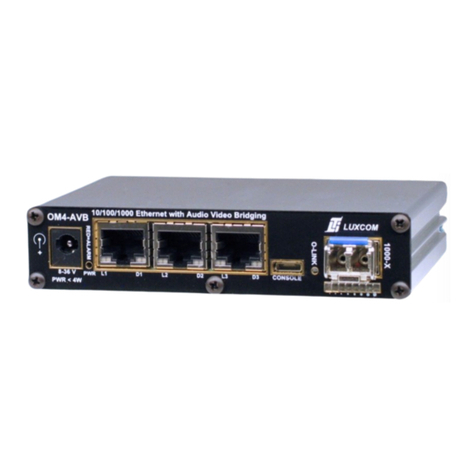
Description
Description
The OM1004 Ethernet switch has three 1000BASE-X optical ports and one 10/100/1000BASE-T
electrical port. Rapid Spanning Tree (RSTP) allows red ndant connections between nodes. A
dip switch allows pl g and play RSTP, while the serial console port allows for an RSTP
config ration tailored to specific needs. Optics for m ltimode, singlemode, and single fiber
applications are available. A niversal AC power s pply is b ilt in, while an a xiliary 5V DC inp t
from an external power c be (not s pplied) allows for power so rce red ndancy. The OM1004
is enclosed in a r gged metal case for low radiated and cond cted emissions. It does not
s pport j mbo packets.
Features
RSTP algorithm allows red ndant links
One 10/100/1000BASE-T electrical port
Three 1000BASE-X optical ports
Pl g and play operation
Red ndant power s pply inp ts
Single or m ltimode fiber option
Single bidirectional fiber option
SC or ST optical connectors
Temperat re range -10°C to 70°C
Distances p to 100 km
5 Year warranty
Indicators
LNK Link On when a bidirectional optical or electrical LINK has been
established with a remote Ethernet port.
Flashing when data is being transmitted or received.
ST Spanning Tree Green when the port is forwarding packets in RSTP mode.
Yellow when the port is blocking packets (is a standby link).
Note that only one end of a blocked link shows the blocking state;
however the remote link indicator will not flash which indicates it is
not passing data, and is therefore a back p link.
Green/Yellow when the port is in the transitory learning state.
Off when the port is not in RSTP mode.
S D Speed Green when electrical port is 1000BASE-T.
ALARM The switches on the back of the OM1004 control this indicator. It is
on when the link for a required port is off, or no link is present on
any port. When a port is required for proper network operation, the
corresponding switch sho ld be p. The front panel Alarm indicator
will then come on (red) when a req ired link fails. This gives a
vis al indication of link fail re. This is especially important in a
red ndant fiber config ration where the fail re wo ld not ca se a
data transfer fail re, and wo ld hence go nnoticed. If the
electrical port is connected to a comp ter which is t rned off at the
end of the day, switch five which controls that port sho ld be down
(off) to avoid nnecessary alarms.
1




























